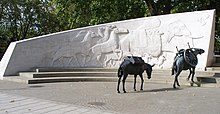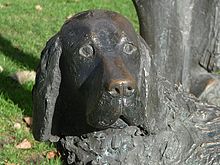Animals in War Memorial
The Animals in War Memorial commemorates the animals used, injured and killed in wars and conflicts under British command. It is located in London east of Hyde Park on Park Lane at Brook Gate (approx. 300 m south of Marble Arch ). It was made by the English sculptor David Backhouse and was unveiled by Princess Anne on November 24, 2004 .
construction
The memorial consists of two curved limestone walls with a narrow passage and bronze animal sculptures that “walk through” the wall. On the pavement of the lower level, two heavily laden mules stumble towards the gap between the walls. Beyond the wall (from the raised lawn) a dog looks back at some distance , in the very front (= in the north) there is a bronze horse. The longer left (western) wall shows bas-reliefs of many animal species that were used in armed conflicts in the 20th century, among others. a. Horses , dromedaries , goats , dogs, carrier pigeons and elephants . The right wall bears the inscriptions (see below). The silhouettes of the animals are cut out on the back of the longer wall , the main donors are listed on the shorter wall .
The entire monument measures 17.68 m by 16.76 m.
Inscriptions
The memorial bears two separate inscriptions under the words "Animals in War" :
"This monument is dedicated to all the animals
that served and died alongside British and allied forces
in wars and campaigns throughout time"
("This memorial is dedicated to all animals that have served and died in wars and conflicts in the British and Allied forces at all times.")
The second (left) inscription reads:
"They had no choice"
("They had no choice.")
history
Many millions of animals were used in the armed forces and countless were killed. Horses, mules and donkeys served as transport animals and died in fighting or perished from injuries, exhaustion, epidemics, hunger and thirst. In the First World War alone , eight million transport animals died in the armies of Great Britain, the Commonwealth and the Allies. Dogs served as messengers, watchdogs and sniffer dogs. During the First World War, more than 100,000 and in the Second World War more than 200,000 carrier pigeons were used by the British. In the 20th century, elephants, camels, oxen, canaries and even fireflies were used by the armed forces.
The impetus for the erection of a monument came from the book Animals in War , written by Jilly Cooper in collaboration with the Imperial War Museum . A donation of £ 1,400,000 made the construction of the monument possible.
Web links
- Official website of Animals in War Memorial Fund (English)
- Patrick Roberts: The Animals in War Memorial . In: Purr-n-Fur.org.uk (English)
- Article on the sculptor and the memorial . In: BBC , November 25, 2004 (English)
Individual evidence
- ↑ "The Animals In War Memorial" May 18, 2012.
- ↑ "The Animals In War - History" May 20, 2012.
Coordinates: 51 ° 30 ′ 39.8 " N , 0 ° 9 ′ 27.2" W.





